Queen Boxes, cases, 1971- 1980 – Early Collector Period
Fred Fisher, Brian Guth, Ashley and Joe Mick, and Dan Lago
Queen Cutlery entered the collector market shortly after Servotronics took over ownership of the company in 1969. They made few changes in their first year, but by the 1972 catalog #50, they began to prepare for making more collector/commemorative knives rather than “just tools.” The process took almost eight years as they gradually built a reputation for making fine knives.
As can be seen in the first installment of “boxes” covering the period 1947 – until specialized commemoratives with their own box, basic Queen knives were still sold largely in displays with shipping boxes containing “half dozen” units through 1978-79 (Please refer to Queen Boxes 1947-1971, and then see figure 5, regarding the #11 knife).
Queen started producing early efforts with their own name, beginning in 1972, with the Drake Well commemorative barlow knife, model #139, (see figure 1). We do not think, currently, that this knife was sold in any kind of Commemorative-style box. None has been seen with the knife and multiple serious collectors who bought the knife new from major dealers do not have an original box. Thanks to Mr. Lee Cannon and Brian Guth’s detective work we now have proof that this knife was shipped in the traditional “half dozen box (see figure 2).
As Queen’s first collector-oriented knife a few comments are in order. Titusville, PA was the site of the Drake oil well success in 1859 and the source of its early growth. The community has always had an annual “Oil Festival,” and the Drake Well barlow was made specifically for the oil days festival and marketed essentially locally. The knife gradually earned more attention and a second edition was produced in the late 1970s – which was promoted in price lists and the 1980 catalog (still using the 1972 unique tang stamp (1972). https://queencutleryguide.com//wp-content/uploads/2019/11/Model-139-10-2019.pdf. Our point is the knife was not “boxed” beyond regular methods by the company.
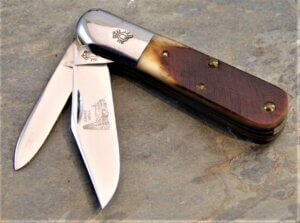
Figure 1. 1972 Drake Well commemorative 2-blade clip Barlow with sawcut brown bone. Had one-year only “1922-1972 tang stamp” on both blade and bolster.
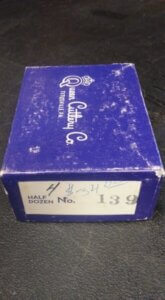
Figure 2. Drake Well Barlow shipping box, (Courtesy of Mr. Lee Cannon, who bought this knife in volume at the time of the first edition.)
The Drake Well Barlow was followed by a 200-year Kentucky knife set in 1974, with a peanut and a 2-blade stockman with red acrylic handles and a Kentucky state shield. This set was offered in a plastic case, clear on top and black bottom – It is the only knife Queen produced with a plastic box and was not considered a major financial success.
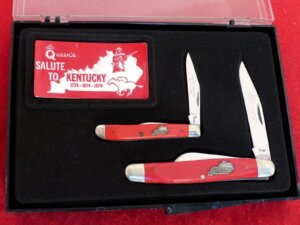
Figure 3. 1974 Kentucky 200-year Commemorative Set in Plastic Box
Queen moved forward in 1976 with two offerings for the Bicentennial of the United States. One was a daddy Barlow in smooth black delrin with special blade etch and large early U.S. flag shield. This knife was held on a pine board with a clear cellophane wrapper. The set was issued in a huge edition of 15,000, and featured the serial number of each knife on the pile side bolster and on a paper attached on the backside of the pine board – a very nice consideration. The ’76 tang was also on blade and mark side bolster (See Figure 4). The size of the edition and features of the knife as well as the cellophane wrap to hold the knife for wall mounting have not found huge favor with collectors, so this knife can still be found readily on Internet sales.
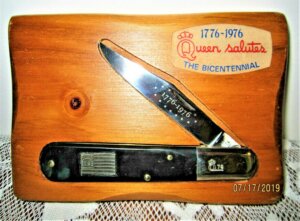
Figure 4. The Single-bladed Daddy Barlow 1976 bicentennial knife on a pine wall display (cellophane wrapper has been removed.)
In the 1970s Queen also greatly improved the boxes for its series of fixed blade knives in the Gamekeeper series (See Figure 6). Each large box opened to show the knife and sheath in a display setting. Made with micarta handles, very nice sheath, and more modern “mass” for the knives (especially compared to Queen’s traditional fixed blades), many of these knives are still found with the boxes – often in almost unused condition. This series also had serial numbers on each knife – rare in a catalog knife.
The rarest knife in the Gamekeeper series was the #396 lever lock skinner – it was never shown in a catalog and offered for only a very short time. Figure 5, shows a copy of the box for this knife, with the model number on the end.
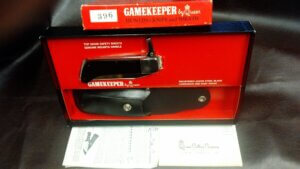
Figure 5. The Lever lock Folding Skinner was made on the #390 gamekeeper frame and to our knowledge is the only lever lock Queen ever produced. We are told “less than 100” of this knife were made.
While the Gamekeeper series also included a number of pocket knives also handled in black micarta, they were not boxed in any special way and have largely been ignored by Queen Collectors. In our opinion they are a great set of pocket knives – way ahead of their time. The boxes mattered for the fixed blade knives in this series.
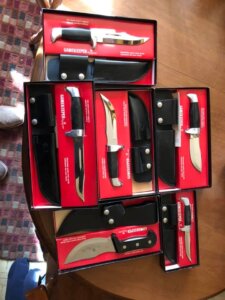
Figure 6. The GAMEKEEPER fixed blade series from 1972-1980, were extremely well packaged with each knife and sheath displayed in a box that fit the knife, and with model # numbers on the side of the box.
The Master Cutler Collection in the very late 1970s showed significant advances in boxing. There are two versions: an initial cardboard box in a medium brown color (figures 7 & 8) and a later clamshell box in a medium olive brownish color (see Figures 8 & 9).
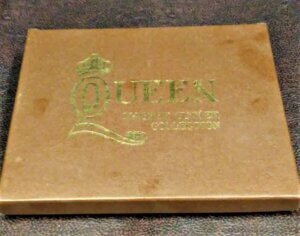
Figure 7. Exterior of the Master Cutler box for the Gunstock knife, 1978, the first of this popular series.
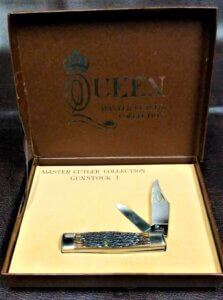
Figure 8. Interior of Master Cutler Gunstock, showing recess for placing, name, and ribbon for holding box lid open, 1978-1980.
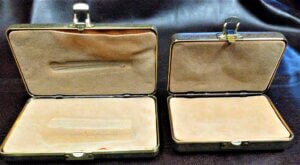
Figure 9. Interior of the Master Cutler Collection Clamshell holders.
Note velveteen interior with recess for the specific knife and label for the knife and year (on upper inside cover – sorry, hard to see in this image). This image taken from Internet also demonstrates how a box may be lost from an original knife. There were two different sizes of these clamshell boxes; left for the “old fashion Lockback” and right for the “peanut.”
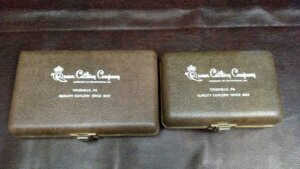
Figure 10, Exterior of a Master Carver Clamshell Box, 1979, showing a very early “Knife Q” logo.
This image shows why many collectors think the knife depicted is the gamekeeper series “Big Moose.”
This “Master Cutler Collection,” one of Queen’s first very successful collector series is profiled: https://queencutleryguide.com//wp-content/uploads/2019/11/Master-Cutler-10-2019.pdf.
Knives in this collection were serialized, but sometimes in a way that was hard to detect. The large and small trapper offering had matching serial numbers on the outside brass lining on the spey blade side of the knives (see Figure 11).
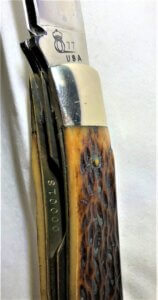
Figure 11, Showing serial number on the inside brass liner on both trappers in the Master Cutler Collection, 1977.
Clearly for the Master Cutler Collection, having a box in good shape greatly enhances the value of the piece.
So, in the 1970s Queen started to pay more attention to how commemorative or limited-edition knives were boxed and showed considerable progress over the decade, from “no box” to highly effective specialized permanent boxes meant for display and protection – an integral part of the knife meant for collectors.
References.
Mr. Lee Cannon. (2020) Personal communication. “Boxes used for Drake Well Barlow.”
Mr. Fred Sampson (2017) Personal communication. “Production of Gamekeeper #396.”

![Figure 7[81] Figure 7. Exterior of the Master Cutler box for the Gunstock knife, 1978, the first of this popular series.](https://queencutleryguide.com/wp-content/uploads/elementor/thumbs/Figure-781-pziha8u613crjv5p6sje40m3on59hwhkby4dutp1fs.jpg)

